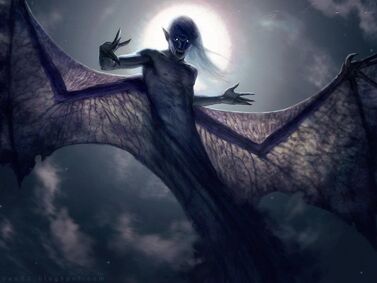
Aswang.
An Aswang is a shapeshifting monster usually possessing a combination of the traits of either a vampire, a ghoul, a witch, or different species of werebeast in Filipino folklore or even all of them together.
Overview[]
It is the subject of a wide variety of myths and stories. Spanish colonists noted that the Aswang was the most feared among the mythical creatures of the Philippines, even in the 16th century.
Despite their fearsome reputation, some Aswangs can also be befriended and engage in social activities like any normal human: they laugh and/or cry, get angry, get hurt/humiliated and feel envious. These Aswang do not harm their friends and neighbors, instead choosing unknown strangers as their prey, with some even going as far as to travel to other villages in order to avoid devouring them.
Description[]
Due to being shapeshifters, the appearance of the Aswang varies from tale to tale. However, one thing that all stories seem to agree upon is that Aswangs are shapeshifters. Stories recount aswangs living as regular townspeople, quiet, shy and elusive, who at night would transform into creatures such as a cat, bat, bird, boar or dog in order to get around. When hunting, the aswang would manifest in number of monstrous forms in order to mimic the powers of several supernatural predators.
Vampire[]
The Vampire Aswang disguise themselves in the shape of beautiful women. They share their diet of blood with the vampires of Western cultures, however, the aswang differ by sucking blood using proboscis-like tongues, rather than fangs. Vampire aswang tend to live alone in forests far from human communities, but can also infiltrate human society by means of marrying into a community. These aswang will either slowly drain their husbands of blood over many years, or they may merely use their marriage as cover, so they can prey upon the villagers at night while remaining unsuspected during the daytime. One example of a vampire aswang is the Tagalog mandurugo, said to live in the region of Capiz.
Manananggal[]
The Manananggal' or Separators, are the most common of the Aswang, and said to feed exclusively on internal organs, or the phlegmatic discharge of the sick. By day, Manananggal take the form of attractive, light-skinned, and long-haired women. As the sun sets upon the horizon, Manananggal will sprout wings from their backs and segment themselves, leaving behind their bodies from the waist downwards. Aswang will take great care to hide their lower half before flying in searches for victims. Manananggal particularly attracted to the fetuses growing inside pregnant women, and will stalk these women relentlessly, waiting for an opportunity to attack. If this food source cannot be found, aswang will instead target small children, favoring livers and hearts which they pierce with their wicked tongues before devouring them whole.
Weredog[]
Maximo Ramos reasons that the werecreature of a given region is named after their most ferocious creature. As such, for example, Europe has werewolves, India has weretigers, Africa has wereleopards, and Russia has werebears. The Philippines has no indigenous wolf population, thus making "weredog" the more appropriate term. Like the previous aswang, the weredog infiltrates villages and turns into a creature by night, around midnight. Once in this feral state, the aswang will kill and eats people traveling on the road in the night, using their supernatural stealth to ambush unwary prey. Unlike the previous aswang, the weredog does not infiltrate human communities through marriage, but as a traveler of some sort, such as a peddler or a construction labourer.
Ghoul[]
Ghoul aswang are described as sickly humanoids who feed solely on human corpses and other carrion. Their nails and teeth are adapted to be sharp and strong in order to help with the theft and consumption of corpses from their tombs. Their diet makes them smell rank and pungent enough to repel those seeking to attack them at close range, as the stench is so overpowering. Ghoul Aswang gather in trees near cemeteries to exhume and consume fresh burials, only appearing at night to carry on these tasks. Before daybreak, Ghoul Aswang will return to the thicket of trees they emerged from before disappearing completely come sunrise.
Abilities[]
While Aswang primarily rely on their shapeshifting abilities to remain unnoticed, some also possess a number of abilities which aid them with their predation of humans. Many Aswang are able to alter sound in such a way as to make them sound initially loud and nearby when in reality they are far away, and quiet as they get closer to their target, who may think the Aswang is getting farther away. This sound distortion allows the aswang to confuse potential victims and lure them closer to their demise.
Some Aswang have come to rely on witchcraft and the dark arts as their source of power, laying curses upon those who have crossed them that make make certain objects such as rice, bones, or insects, come out of the bodily orifices of the cursed. Witch Aswang are greatly feared in the Philippines, even by those who generally reject the idea of other supernatural entities. If a witch aswang is caught, they are to be immediately killed without question, as they pose a great risk to those around them. They are considered by many to be one of the strongest supernatural entities in Asia.
Weaknesses[]
Like vampires, aswangs are repelled or killed by using garlic, salt and religious artifacts/weapons (e.g. Holy water, crucifix, rosary). They are also killed using a whip made entirely of a stingray's tail, which may also be used to repel the creature (aswangs are said to be scared of the sound made by the whip slashing through the air). It is also said that they cannot step on holy consecrated ground (i.e. churches). Decapitation is also a way to destroy an aswang.